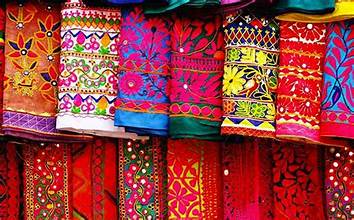Rajasthan, known as the Land of Kings, boasts a rich artistic and cultural heritage deeply intertwined with colors. From magnificent palaces and intricate paintings to vibrant textiles and grand festivals, colors have played a crucial role in symbolizing traditions, emotions, and social status. Each shade in Rajasthani art and royal culture tells a unique story, reflecting the state’s deep-rooted history. The role of color in Rajasthani art and royal culture is deeply rooted in tradition, with vibrant hues shaping architecture, textiles, paintings, and festive celebrations.
1. Symbolism of Colors in Rajasthani Culture
Colors hold profound significance in Rajasthan, shaping religious beliefs, clothing, and even architecture.
- Red: Symbolizes power, passion, and marital bliss. Brides traditionally wear red lehengas, and royal warriors adorned red turbans.
- Yellow: Represents prosperity and happiness. Saffron and yellow hues dominate religious events and festivals.
- Blue: Denotes divinity and protection. The famous Blue City of Jodhpur is a testament to this belief.
- Green: Stands for fertility, nature, and growth. It is prominently used in textiles and traditional attire.
- White: Reflects purity and peace, often seen in royal mourning rituals and temple architecture.
2. Color in Rajasthani Paintings
Rajasthani miniature paintings, a celebrated art form, showcase a mesmerizing blend of bold colors. These paintings, especially in Mewar, Marwar, and Kishangarh styles, depict royal life, mythology, and nature.
Key Features of Color in Miniature Paintings:
- Gold and red enhance regal elements.
- Natural dyes from flowers, stones, and minerals create long-lasting pigments.
- Artists use vibrant backgrounds to highlight figures and emotions.
3. Colors in Royal Architecture
Rajasthan’s forts and palaces are not just grand in structure but also in color. The use of pink in Jaipur, blue in Jodhpur, and golden hues in Jaisalmer reflects the region’s connection to its natural surroundings.
- Jaipur (The Pink City): Pink was chosen to symbolize hospitality when the city welcomed the Prince of Wales in 1876.
- Jodhpur (The Blue City): Houses painted in blue historically signified Brahmin residences and also helped keep interiors cool.
- Jaisalmer (The Golden City): The sandstone buildings glow golden under the sun, adding to the city’s majestic beauty.
4. Color in Rajasthani Textiles and Fashion
Rajasthan’s textiles are known for their bold patterns and lively hues. Bandhani (tie-dye), Leheriya, and block printing showcase vibrant colors that define the state’s traditional fashion.
- Royal attire featured gold and red to signify wealth and power.
- Brides wear rich red, pink, and orange, symbolizing joy and prosperity.
- Men’s turbans display different colors based on region and occasion.
5. Colors in Festivals and Celebrations
Rajasthan’s festivals are a visual spectacle of colors. The Gangaur and Teej festivals feature women in colorful attire, while Holi transforms streets into a riot of colors. The Pushkar Camel Fair and Marwar Festival also highlight the cultural vibrancy of Rajasthan.
Conclusion
The role of color in Rajasthani art and royal culture extends beyond aesthetics; it embodies emotions, traditions, and social identity. From palaces to textiles and paintings to festivals, color remains a defining element of Rajasthan’s regal charm.



